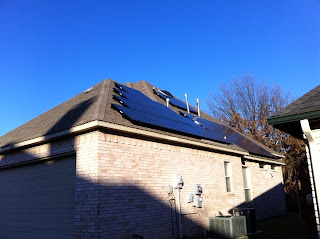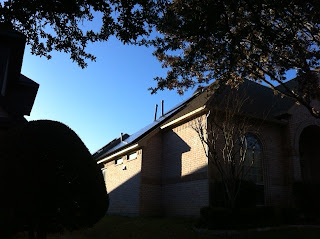 On that note, I logged into my account online and took a screenshot of the "current electricity details" portion of my March 2012 bill (my rep is Reliant, could this information may be called something similar with TXU or Green Mountain statements).
On that note, I logged into my account online and took a screenshot of the "current electricity details" portion of my March 2012 bill (my rep is Reliant, could this information may be called something similar with TXU or Green Mountain statements).The first thing to notice is the "29 day billing period". Why is this not simply the first day of the month to the last day of the month? Most likely because my old analog electricity meter required someone to physically come and read the meter values for billing purposes. My premise (home) was probably lumped together with other homes in my area into a "billing cycle", while taking into account weekends and holidays, and given the dates of 3/6/2012 to 4/4/2012 so that the meter reader could more conveniently read as many meters as possible.
Of course, with the new smart meters, I'm guessing it's really not necessary to have the billing cycle fall on these predetermined dates since a meter reader person is no longer necessary. However, it's probably more of a legacy billing system and business process holdover for utilities to do it this way.
In the future, as utilities' IT systems mature, I'd hope that they would allow customers to choose the dates for each month's billing cycle since one of the advantages of smart meters is the granularity of the data (15 minutes, so daily sums are easily possible).
 At left are more screenshots, including portions of my April and May electricity bills.
At left are more screenshots, including portions of my April and May electricity bills. Again, notice the billing days each time. My April bill shows 4/4/2012 to 5/4/2012, while my May bill shows 5/4/2012 to 6/5/2012. Interestingly, the date of 5/4/2012 shows up in both statements, so which one is correct?
Again, notice the billing days each time. My April bill shows 4/4/2012 to 5/4/2012, while my May bill shows 5/4/2012 to 6/5/2012. Interestingly, the date of 5/4/2012 shows up in both statements, so which one is correct?What is missing here are the times on those dates for which meter readings are included. My best guess is that "start date" is inclusive of all hours on that day, while the "end date" is exclusive of that day's hours (meaning midnight). In other words, my April bill would go from 12:00am on 4/4/2012 to 12:00am on 5/4/2012. What do you think?
 At right are a few more screenshots, this time from my Summer electricity bills.
At right are a few more screenshots, this time from my Summer electricity bills.The next line items to notice are the Energy Charge (which I explained briefly here) and the Grid Credit (which is touched on here).
 My rate is the same in each bill (meaning it's a fixed rate) and the usage was steadily increasing from March through May (551 kWh to 946 kWh consumed). This indicates that it was getting warmer and my A/C was in use a bit more each month. Since we us natural gas in my home for heating, I expect this trend to reverse once the Fall months come around.
My rate is the same in each bill (meaning it's a fixed rate) and the usage was steadily increasing from March through May (551 kWh to 946 kWh consumed). This indicates that it was getting warmer and my A/C was in use a bit more each month. Since we us natural gas in my home for heating, I expect this trend to reverse once the Fall months come around.Also, notice that the rate for Grid Credit was the same as the Energy Charge ($0.092 per kWh). This is the great thing about have a rate plan that pays me back for excess solar power placed back onto the grid.
Interestingly, since I know that my solar panel system produces at least 800 kWh in the Spring/Summer months, I can simply subtract the Grid Credit kWh number from the amount of energy I produced in that month to figure out how much of my solar production I consumed that same month.
So it's apparent that I'm saving some money each month with solar power, but what's the difference compared to last year? Glad that I asked!
 At left is one final screenshot, from my August bill, of the "electricity usage summary" section.
At left is one final screenshot, from my August bill, of the "electricity usage summary" section.The difference between August 2011 and August 2012 was about 1400 kWh, about 50% less. Since solar power provided about 600 kWh of my total consumption, my bill without solar would have showed about 2000 kWh sans solar power. Then, where's the 800 kWh difference coming from?
One potential culprit is the Billing Days line item. However, last year my August billing cycle had fewer days than the same period this year, so that should have led to a smaller difference.
Another factor could have been that we were more diligent in watching our electricity use, such as turning off various electronics when not in use and turning up the thermostats another degree (while using ceiling fans instead). This would probably have a measurable effect on energy savings, although it would take some effort to determine the exact amount (time to finally plug in my home energy monitor!).
One last factor to consider is the average high temperature in the billing period. Last year in August, Texas had it's worst heat wave ever, with average highs measured at 104 degrees F. However, this year has been much tamer, with average highs around 97 degrees F. I believe this is the primary reason for the 800 kWh difference between August last year and this year.
Anyways, I hope this provided some useful insights into the billing aspects that a solar energy home owner sees these days. Please feel free to post any questions and I'll try to get back to you sooner than my recent post history would indicate...










